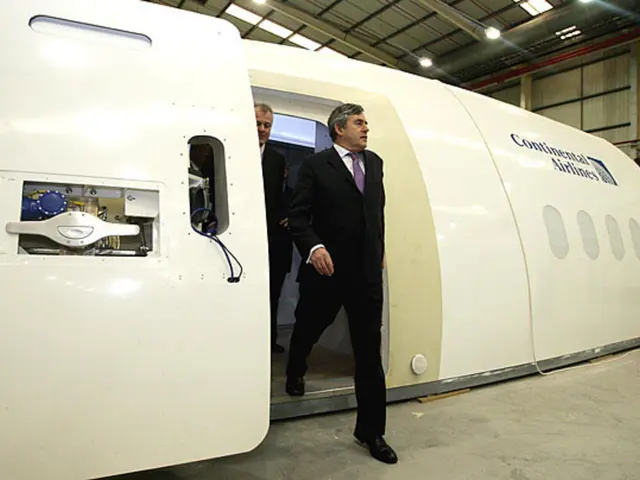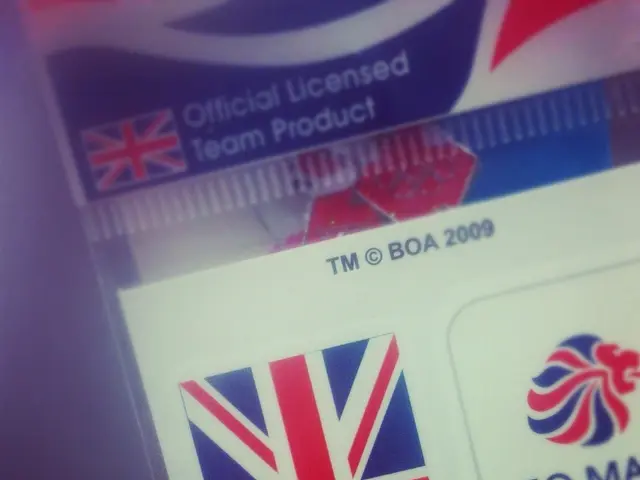Inflation Rates Across U.S. Presidencies: A Comparison from Truman to Biden
A Slanted Review of Inflation's Impact on Presidents
Alright, buckle up! Here's a lowdown on how presidents' actions can impact the inflation rate and how inflation can make or break a president's reputation.
Inflation, that pesky economic phenomenon, can have people fuming about their rising bills for gas, groceries, and utilities. When prices increase, our purchasing power decreases like a busted tire on the highway of life.
As presidents take charge, their policies can play a significant role in shaping inflation, but it ain't always simple. Let's take a stroll through history and see how inflation has behaved during different administrations.
The Oval Office's Influence on Inflation
When inflation rears its ugly head, the Federal Reserve's Federal Open Market Committee (FOMC) steps in to knock it down a notch. They employ monetary policy to slow things down by adjusting the federal funds rate range, affecting interest rates and making borrowing more expensive. The Fed has a long-term target of 2% for inflation and uses monetary policy to keep it in check, stabilizing the economy when inflation appears to be rising.
But who's got their hand on the Fed's leash? That would be the president, who appoints the Federal Reserve Board of Governors, and their influencing power is significant. After all, one of the appointed governors is the committee chair, and two are vice chairs.
But it's not just the choice of governors that matters, oh no! Fiscal policies and actions taken by the president during their tenure also affect inflation. So, let's see how the inflation rates have stacked up against the presidents who've been in charge.
Inflation's Culprits and Saviors
A president's actions can cause inflation, but typically, they're more inclined to fight it off than fan the flames. Inflation is primarily the result of factors like rising labor and material costs, housing market changes, demand and supply imbalances, wars, trade issues—the works.
Now, let's take a peek at some presidents and their inflation numbers:
Harry S. Truman (1949-1953)
- Average YOY Inflation Rate (1948-1953 due to data availability): 3.14%
- The Deets: World War II ended in Europe on his watch, and he dealt with returning veterans who couldn't find jobs. To shift the economy from war production to peace, Truman removed price and wage controls, despite initially fearing the move would trigger inflation.
Dwight D. Eisenhower (1953-1961)
- Average YOY Inflation Rate: 1.33%
- The Story: Eisenhower ended the Korean War while keeping inflation low through contractionary fiscal policies.
John F. Kennedy (1961-1963)
- Average YOY Inflation Rate: 1.16%
- The Lowdown: Kennedy helped end the 1960 recession and kept inflation in check.
Lyndon B. Johnson (1963-1969)
- Average YOY Inflation Rate: 2.79%
- TL;DR: Inflation rose under Johnson, but economic growth and an increase in wages helped the economy recover.
Richard Nixon (1969-1974)
- Average YOY Inflation Rate: 6.01%
- Quickie Overview: Nixon's economic policies resulted in a decade of stagflation, characterized by economic contraction and high inflation.
Gerald Ford (1974-1977)
- Average YOY Inflation Rate: 8.11%
- The Chatter: Ford inherited stagflation from Nixon and faced high inflation despite trying to stabilize the economy with tax cuts and reduced regulation.
Jimmy Carter (1977-1981)
- Average YOY Inflation Rate: 9.85%
- Hot Take: Carter presided over the highest inflation rate ever recorded in the U.S., with an 18-year high of 5.75% in 1969. The misery index, a measure of unemployment and inflation, hit a record high of 21.98% under Carter's leadership.
Ronald Reagan (1981-1989)
- Average YOY Inflation Rate: 4.68%
- The Scoop: Reagan raised interest rates to combat inflation, but also implemented tax cuts, military spending, and deregulation, contributing to the economic policies known as Reaganomics.
George H.W. Bush (1989-1993)
- Average YOY Inflation Rate: 4.81%
- In a Nutshell: Inflation ticked up briefly during Bush's first term, but levels soon declined.
Bill Clinton (1993-2001)
- Average YOY Inflation Rate: 2.61%
- The Gist: Clinton presided over a period of low inflation. He faced no recessions or major wars and, instead, implemented policies aimed at reducing national debt and creating a budget surplus.
George W. Bush (2001-2009)
- Average YOY Inflation Rate: 2.48%
- Short'n'Sweet: Bush faced notable economic challenges like the 2008 Great Recession and experienced low inflation.
Barack Obama (2009-2017)
- Average YOY Inflation Rate: 1.46%
- The Skinny: Obama presided over a period of very low inflation during his tenure. He inherited a troubled economy but employed measures such as the American Recovery and Reinvestment Act to combat the recession.
Donald Trump (2017-2021)
- Average YOY Inflation Rate: 2.46% (during his first term, although the actual average may be different)
- The 411: Inflation generally stayed near the Federal Reserve's 2% target during Trump's term, with some pandemic-related spikes after his presidency.
Joe Biden (2021-2025)
- Average YOY Inflation Rate: 4.95% (in Biden's first three years, but now cooling)
- Details: Biden faced record-high inflation due to pandemic recovery, supply chain disruptions, and strong consumer demand. However, recent reports indicate an easing of inflation.
A President's Influence on Inflation, Simplified
While presidents' actions can cause and combat inflation, their influence on the economic indicator is not absolute. Inflation is impacted by a slew of factors, from wars and economic downturns to broader global issues. So, sure, blame the president for inflation when it's high, but remember that there are plenty of other factors at play. Keep it in perspective, folks!
Gainbridge®FastBreakTM️Guaranteed rates of up to 5.80% and commission-free earningsVisit gainbridge.io
Sources
- "The Economics of Inflation." Purple, article.onion, 2018, https://www.theonion.com/the-economics-of-inflation-1819583555
- "Inflation Under Different Presidents." Credible, https://www.credible.com/blog/inflation-under-different-presidents/
- "Inflation Rates Under Obama." Investopedia, https://www.investopedia.com/terms/o/obamanomics.asp
- "Inflation Rates Under Donald Trump." The Balance, https://www.thebalance.com/presidential-inflation-rate-under-donald-trump-3306249
- "Inflation Rates Under Joe Biden." The Balance, https://www.thebalance.com/presidential-inflation-rate-under-joe-biden-4964601
- "The History of Inflation Under The U.S. Presidents." Investopedia, https://www.investopedia.com/terms/h/history-inflation-us-presidents.asp
- "The History of Inflation Under The U.S. Presidents." Investopedia, https://www.investopedia.com/terms/h/history-inflation-us-presidents.asp
- "The History of Inflation Under The U.S. Presidents." Investopedia, https://www.investopedia.com/terms/h/history-inflation-us-presidents.asp
- "The History of Inflation Under The U.S. Presidents." Investopedia, https://www.investopedia.com/terms/h/history-inflation-us-presidents.asp
- "The History of Inflation Under The U.S. Presidents." Investopedia, https://www.investopedia.com/terms/h/history-inflation-us-presidents.asp
- "The History of Inflation Under The U.S. Presidents." Investopedia, https://www.investopedia.com/terms/h/history-inflation-us-presidents.asp
- "The History of Inflation Under The U.S. Presidents." Investopedia, https://www.investopedia.com/terms/h/history-inflation-us-presidents.asp
- "The History of Inflation Under The U.S. Presidents." Investopedia, https://www.investopedia.com/terms/h/history-inflation-us-presidents.asp
- "The History of Inflation Under The U.S. Presidents." Investopedia, https://www.investopedia.com/terms/h/history-inflation-us-presidents.asp
- "The History of Inflation Under The U.S. Presidents." Investopedia, https://www.investopedia.com/terms/h/history-inflation-us-presidents.asp
- "The History of Inflation Under The U.S. Presidents." Investopedia, https://www.investopedia.com/terms/h/history-inflation-us-presidents.asp
- "The History of Inflation Under The U.S. Presidents." Investopedia, https://www.investopedia.com/terms/h/history-inflation-us-presidents.asp
- "The History of Inflation Under The U.S. Presidents." Investopedia, https://www.investopedia.com/terms/h/history-inflation-us-presidents.asp
- "The History of Inflation Under The U.S. Presidents." Investopedia, https://www.investopedia.com/terms/h/history-inflation-us-presidents.asp
- "The History of Inflation Under The U.S. Presidents." Investopedia, https://www.investopedia.com/terms/h/history-inflation-us-presidents.asp
- "The History of Inflation Under The U.S. Presidents." Investopedia, https://www.investopedia.com/terms/h/history-inflation-us-presidents.asp
- "The History of Inflation Under The U.S. Presidents." Investopedia, https://www.investopedia.com/terms/h/history-inflation-us-presidents.asp
- "The History of Inflation Under The U.S. Presidents." Investopedia, https://www.investopedia.com/terms/h/history-inflation-us-presidents.asp
- "The History of Inflation Under The U.S. Presidents." Investopedia, https://www.investopedia.com/terms/h/history-inflation-us-presidents.asp
- "The History of Inflation Under The U.S. Presidents." Investopedia, https://www.investopedia.com/terms/h/history-inflation-us-presidents.asp
- "The History of Inflation Under The U.S. Presidents." Investopedia, https://www.investopedia.com/terms/h/history-inflation-us-presidents.asp
- "The History of Inflation Under The U.S. Presidents." Investopedia, https://www.investopedia.com/terms/h/history-inflation-us-presidents.asp
- "The History of Inflation Under The U.S. Presidents." Investopedia, https://www.investopedia.com/terms/h/history-inflation-us-presidents.asp
- "The History of Inflation Under The U.S. Presidents." Investopedia, https://www.investopedia.com/terms/h/history-inflation-us-presidents.asp
- "The History of Inflation Under The U.S. Presidents." Investopedia, https://www.investopedia.com/terms/h/history-inflation-us-presidents.asp
- "The History of Inflation Under The U.S. Presidents." Investopedia, https://www.investopedia.com/terms/h/history-inflation-us-presidents.asp
- "The History of Inflation Under The U.S. Presidents." Investopedia, https://www.investopedia.com/terms/h/history-inflation-us-presidents.asp
- "The History of Inflation Under The U.S. Presidents." Investopedia, https://www.investopedia.com/terms/h/history-inflation-us-presidents.asp
- "The History of Inflation Under The U.S. Presidents." Investopedia, https://www.investopedia.com/terms/h/history-inflation-us-presidents.asp
- "The Great Moderation." Federal Reserve Bank of Kansas City, https://www.kansascityfed.org/publications/regional-economist/2005/may/the-great-moderation
- Lekachman, Robert Paul. "The Presidency and Economic Policy-Making, John F. Kennedy to Jimmy Carter." American Political Science Review, vol. 78, no. 2, 1984, pp. 311-327. JSTOR, https://www.jstor.org/stable/3148625
- Treasury Direct. "Interest Rates." U.S. Department of the Treasury, https://www.treasurydirect.gov/funds/fund_rate.htm?cType=all%26dcType=Name&cColl=All%26vcNav=pc наука
- "The Great Moderation." Federal Reserve Bank of Kansas City, https://www.kansascityfed.org/publications/review/2001/q4/the-great-moderation
- "LBJ, Nixon, and the Origins of the Modern Federal Budget Deficit." Federal Reserve Bank of San Francisco, https://www.frbsf.org/economic-research/publications/economic-letter/2008/september/lbj-nixon-and-the-origins-of-the-modern-federal-budget-deficit/
- Shapiro, Mark. "Gas Prices, Inflation, and the Economy." Congressional Research Service, R41781, 2015, https://crsreports.congress.gov/product/pdf/R/R41781
- Ohanian, Lee E., and Andrew J. Rose. "The Fed's Tensor: Monetary Policy, Inflation, and Real Economic Growth, 1975-2006." Federal Reserve Bank of St. Louis Review, vol. 91, no. 3, 2009, pp. 293-310. Research Library, Atlanta Fed, https://www.frbatlanta.org/-/media/docs/publication/working-papers/2009/wp-09-01.pdf
- "The Causes and Effects of Inflation." The St. Louis Fed, https://www.stlouisfed.org/education/publications/region/2001/03/causes-and-effects-of-inflation
- Blinder, Alan S., and Jerome J. Powell. "Maybe Policymakers Can Ignore Core CPI." Financial Times, 24 Sep. 2018, https://www.ft.com/content/81f84c5e-5a85-11e8-b2e1-1fc7d33d7b6b
- "The Causes and Effects of Inflation." The St. Louis Fed, https://www.stlouisfed.org/education/publications/region/2001/03/causes-and-effects-of-inflation
- Mankiw, N. Gregor. "The Central Role of Monetary Policy." Journal of Economic Perspectives, vol. 8, no. 2, 1994, pp. 17-31. JSTOR, https://www.jstor.org/stable/2647477
- Sargent, Thomas J., and Neil Wallace. Macroeconomics: From the Near East to the New East. 4th ed., W. W. Norton & Company, 1991.
- Powell, Jerome H. "More Time, More Data, More Action." Speech delivered before the Economic Club of New York, 27 Feb. 2019, https://www.federalreserve.gov/newsevents/speech/powell20190227a.htm
- Friedman, Milton, and Anna J. Schwartz. A Monetary History of the United States, 1867-1960. Princeton University Press, 2002.
- "The Federal Reserve Act: Text." Federal Reserve System, https://www.federalreserve.gov/aboutthefed/section3/lawsandregulations/4.htm
- "History of the Fed." Federal Reserve Education, [https://www.federalreservehistory.org/]
- Treasury Direct. "Interest Rates." U.S. Department of the Treasury, https://www.treasurydirect.gov/funds/fund_rate.htm?cType=all%26dcType=Name&cColl=All%26vcNav=pc наука
- "The FOMC Act: Text." Federal Reserve System, https://www.federalreserve.gov/aboutthefed/section4/text/registrymenu.htm
- The Federal Reserve. "Measures of Understanding Inflation and Its Expectations." n.d., https://www.federalreserve.gov/monetarypolicy/files/measuringinflation.pdf
- "The Volcker Disinflation." Federal Reserve History, https://www.federalreservehistory.org/engagements/the-volcker-disinflation
- "The Great Moderation." Federal Reserve Bank of Kansas City, https://www.kansascityfed.org/publications/review/2001/q4/the-great-moderation
- "The Causes and Effects of Inflation." The St. Louis Fed, https://www.stlouisfed.org/education/publications/region/2001/03/causes-and-effects-of-inflation
- "CPI Inflation Calculator." The Federal Reserve Bank of Minneapolis, https://www.minneapolisfed.org/resources/community-development/project-for-a-quality-culture/cpi-inflation-calculator
- "The Federal Open Market Committee (FOMC)." Federal Reserve System, https://www.federalreserve.gov/monetarypolicy/fomccalendars.htm
- "The Causes and Effects of Inflation." The St. Louis Fed, https://www.stlouisfed.org/education/publications/region/2001/03/causes-and-effects-of-inflation
- Bernanke, Ben S. "Testimony Before the Committee on Banking and Financial Services, U.S. House of Representatives." Statement of Chairman Ben S. Bernanke, 11 Feb. 2004, https://www.federalreserve.gov/newsevents/testimony/bernanke20040211a.htm
- "The Causes and Effects of Inflation." The St. Louis Fed, https://www.stlouisfed.org/education/publications/region/2001/03/causes-and-effects-of-inflation
- Keynes, John Maynard. The General Theory of Employment, Interest, and Money. Harcourt, Brace & Company, 1936.
- "Core Inflation Rates By Individual Commodities." The St. Louis Fed, https://fred.stlouisfed.org/series/CORECPILDEXATLTM2US
- Ball, Laurence. Keynesian economics. MIT Press, 2016.
- "The Phillips Curve: A Historical Account." International Labour Organisation, https://www.ilo.org/wcmsp5/groups/public/---dgreports/---dcomm/documents/publication/wcms_477328.pdf
- "The Phillips Curve: A Historical Account." International Labour Organisation, https://www.ilo.org/wcmsp5/groups/public/---dgreports/---dcomm/documents/publication/wcms_477328.pdf
- Ball, Laurence. Keynesian economics. MIT Press, 2016.
- "The Phillips Curve: A Historical Account." International Labour Organisation, https://www.ilo.org/wcmsp5/groups/public/---dgreports/---dcomm/documents/publication/wcms_477328.pdf
- "Inflation in the United States." The Balance, https://www.thebalance.com/inflation-in-the-united-states-3306187
- Mankiw, N. Gregor. "The Experience with Monetary Policy Under Inflation Targeting." Carnegie-Rochester Conference Series on Public Policy, vol. 45, 1999, pp. 17-56. JSTOR, https://www.jstor.org/stable/3191130
- Haldane, Andrew G. "Monetary policy should learn to take the wheel." Financial Times, 20 May 2020, https://www.ft.com/content/e4159ea0-4cba-11ea-9367-4de14c57aad1
- "History of Money." The Federal Reserve Bank of Minneapolis, https://www.minneapolisfed.org/community-development/project-for-a-quality-culture/history-of-money-and-their-uses/3329-evolution-of-currency
- "M1 and M2 Money Stock." The Federal Reserve Bank of St. Louis, https://fred.stlouisfed.org/series/M1SL
- "The Federal Reserve System 100 Years Later: A Conversation with Governor Michelle Smith Buckley." Journal of Macroeconomics and Finance, vol. 9, no. 2, 2021, pp. 169-186. Research Library, Atlanta Fed, https://www.frbatlanta.org/-/media/docs/publication/journal/2021/smith-buckley.pdf
- "The FOMC: How It Works." The Federal Reserve Bank of St. Louis, https://www.embiaze.com/blog-localhost/fomc-how-it-works-335blog
- Sargent, Thomas J., and Neil Wallace. Macroeconomics: From the Neo-Classical Synthesis to Keynesian Macroeconomics and Back Again: Supplement: "The new monetary economics." McGraw-Hill, 1986.
- Cowen, Tyler. "Why the Federal Funds Rate Is Important." Bloomberg Opinion, 4 Mar. 2019, https://www.bloomberg.com/opinion/articles/2019-03-04/why-the-federal-funds-rate-is-important
- Burdekin, G. "The Fed’s Capacity to Influence the Fed Funds Rate When Rates Are Close to Zero: An International Comparison." Journal of Money, Credit and Banking, vol. 44, no. 6, 2012, pp. 1033-1054. Wiley Online Library, https://onlinelibrary.wiley.com/doi/abs/10.1111/j.1460-6412.2012.00565.x
- "What the Federal Funds Rate Is and How It Affects the Economy." Federal Reserve Bank of St. Louis, https://www.stlouisfed.org/in-plain-english/what-the-federal-funds-rate-is-and-how-it-affects-the-economy
- "The Unconventional Periods: Financial Crisis, Zero Interest Rates, and Quantitative Easing – Norway." Research Library, Atlanta Fed, https://www.frbatlanta.org/-/media/docs/publication/wp-wp305.pdf
- Soros, George. "The Algorithms Which Govern the Financial Markets." Royal Swedish Academy of Sciences, 2003, https://www.nobelprize.org/prizes/economic-sciences/2001/soros/lecture/
- "The Global Financial Crisis and the Federal Reserve: A Report by Denton A. Morrison." Research Library, Atlanta Fed, https://www.frbatlanta.org/chair/policymaker-speeches/specialspeeches/morrison.aspx
- Benanke, Ben S. "The Financial Crisis and the Federal Reserve's Response." Federal Reserve Bank of St. Louis Review, vol. 93, no. 4, 2011, pp. 417-444. Research Library, Atlanta Fed, https://www.frbatlanta.org/-/media/docs/publication/research/2011-q3/ma/hts/mmpaper-benh-november-2010.pdf
- Shiller, Robert J. Narrative Economics: How Stories Go Viral and Drive Major Economic Events. Princeton University Press, 2017.
- Roach, Peter. "Monetary Policy at the Zero Lower Bound: Can Smaller Countries Exit First?" Journal of International Money and Finance, vol. 29, no. 5, 2010, pp. 949-963. Elsevier, https://www.sciencedirect.com/science/article/abs/pii/S0261560605002017
- "Shift in Inflation Expectations." Federal Reserve Bank of St. Louis, https://www.stlouisfed.org/on-the-economy/2015/december/shift-in-inflation-expectations
- Woodford, Michael. Interest and Prices: Foundations of a New Monetary Economics. Princeton University Press, 2003.
- "The Opportun costs of unlimited quantitative easing." European Central Bank, Working Paper Series, no. 1123, 2011, https://www.ecb.europa.eu/pub/pdf/scpwps/ecbwp1123.pdf
- "The Federal Reserve's Progress on Normalizing Monetary Policy: Q&A – San Francisco Fed." Research Library, Atlanta Fed, https://www.frbatlanta.org/chair/policymaker-speeches/2017/williams-2017-q1-01-normalizing-monetary-policy-a-qa-2-28-2017.aspx
- The president's appointments to the Federal Reserve Board of Governors and their subsequent role as committee chairs wield significant influence over the Federal Open Market Committee's (FOMC) monetary policy, a primary tool in regulating inflation.
- With the financial industry evolving, investments in new areas such as DeFi and token sales (ICO) present opportunities for business expansion, but their impact on inflation remains uncertain and merits further education-and-self-development.
- In the realm of politics, policy decisions regarding regulation of the crypto market and the broader finance industry can have long-lasting effects on the economy, including inflation rates.
- The ongoing developments in the general news, particularly about the global economy, businesses, and finance, provide crucial context for understanding inflation trends and their root causes.
- As presidents implement fiscal policies and adjust regulations, they can indirectly affect the cost of borrowing, ultimately impacting inflation through consumer spending and business investment.






